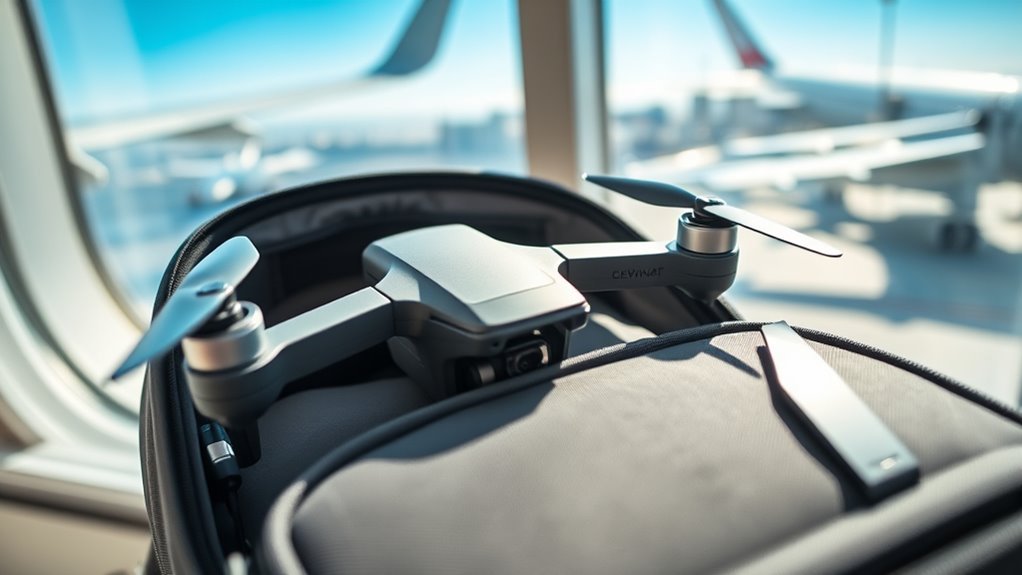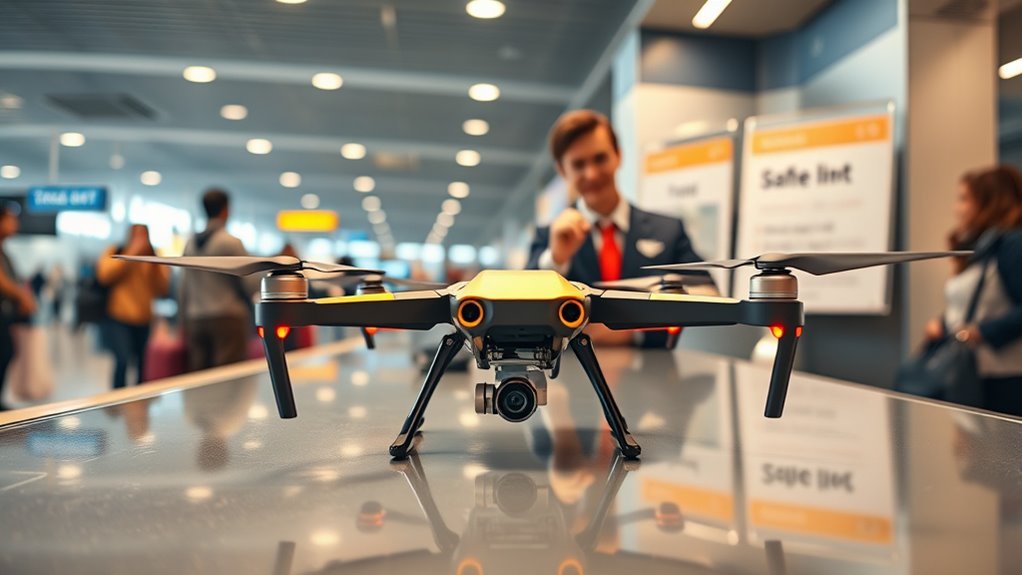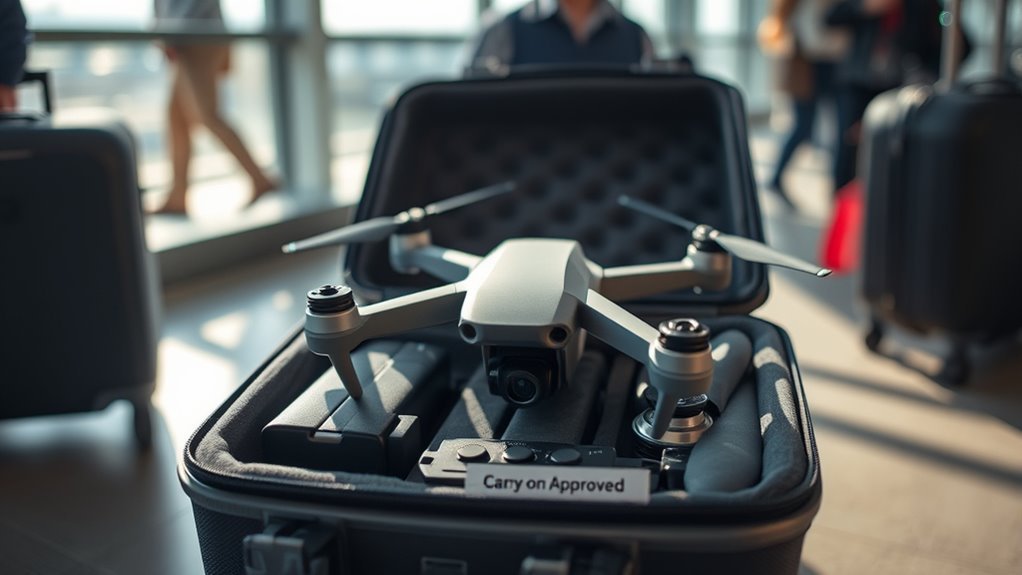To take your drone on a plane, first check your airline’s policies and local regulations at your destination. Make sure to remove batteries and pack your drone securely in a sturdy case, ideally in your carry-on luggage. At security, be prepared to take your drone out for separate screening. Consider drone insurance for liability protection. Respect local laws regarding no-fly zones and altitude limits. Keep reading to uncover more tips for smooth travel with your drone!
Research Airline Policies

Before you pack your drone for a flight, it’s essential to research the airline’s policies, as each carrier has different rules regarding electronic devices. You’ll want to pay close attention to drone size, as some airlines impose restrictions on larger models. For instance, if your drone exceeds the specified dimensions, you might have to check it in, which could raise concerns about damage. Additionally, some airlines may limit the number of batteries you can carry, so be certain to check those restrictions as well. Remember, being informed will save you time and stress at the airport. Freedom to explore is what you seek, so guarantee your drone can accompany you without a hitch on your next adventure.
Understand Drone Regulations at Your Destination

As you plan your trip, understanding drone regulations at your destination is essential to guarantee you don’t run into legal issues. Each country has its own drone registration requirements, so make certain you check if you need to register your drone before flying. Some places may have strict international flying restrictions that could limit where and how you can operate your drone. Familiarize yourself with local laws, including altitude limits and no-fly zones, especially around airports and populated areas. Understanding these regulations not only helps you avoid fines but also assures you can enjoy your flying experience without hassle. Take the time to research, and you’ll be free to capture stunning aerial footage wherever you go!
Prepare Your Drone for Travel

Before you head to the airport, you’ll need to make sure your drone is ready for travel. Start by removing the batteries safely, as most airlines have strict rules about transporting lithium batteries. Then, secure the propellers properly and pack your drone in your carry-on to keep it safe during the flight.
Remove Batteries Safely
When you’re getting ready to travel with your drone, safely removing the batteries is essential to guarantee both your equipment and the airline’s regulations are respected. Start by disconnecting the batteries from the drone, making certain you handle them carefully. For battery storage, use a fireproof bag or case to minimize risk during transit. Confirm the batteries are at an appropriate charge level—typically around 30-50%—as this can prevent damage. If you need to dispose of any old or damaged batteries, follow local guidelines for battery disposal to avoid environmental harm. Taking these steps not only protects your gear but also guarantees a smooth journey, so you can focus on the adventure ahead.
Secure Propellers Properly
Securing your drone’s propellers is an essential step in preparing for travel. Loose propellers can be a safety hazard during your journey, leading to potential damage or accidents. Start by using propeller locks or covers designed specifically for your model. These not only guarantee propeller safety but also protect your drone during transport. Before you pack, check for any signs of wear or damage; proper drone maintenance is important for your device’s longevity and performance. If you notice any issues, replace the propellers before your trip. Remember, a well-prepared drone means more freedom to capture stunning aerial shots once you reach your destination. Taking these precautions will help you enjoy a worry-free travel experience with your drone.
Pack in Carry-On
Packing your drone in your carry-on is essential for ensuring its safety during air travel. Most airlines allow you to take various drone models onboard, but you need to be smart about it. First, disassemble your drone and secure the propellers to prevent damage. Use padded cases or specialized travel accessories to cushion your drone during the journey. Make sure to check the battery regulations, as many airlines have restrictions on lithium batteries. Keeping your drone in your carry-on not only safeguards it but also allows for easier access during security screenings. By taking these precautions, you can travel freely, knowing your drone is protected and ready for your next adventure!
Pack Your Drone Properly
Properly packing your drone is essential for ensuring it arrives at your destination intact and ready for use. To do this effectively, choose a sturdy drone case that fits your model snugly. Use appropriate packing materials to cushion your drone from bumps and drops during travel. Here are some key items to include:
Properly packing your drone ensures it arrives safely and is ready for use upon arrival. Choose a sturdy case and appropriate cushioning materials.
- Foam inserts to secure the drone
- Extra propeller guards to prevent damage
- A battery case to keep your batteries safe
- Zip ties for organizing cables
- A weather-resistant bag for extra protection
Carry-On vs. Checked Baggage
While deciding whether to take your drone as carry-on or checked baggage, it is crucial to contemplate the potential risks and benefits of each option. Carrying your drone on offers several benefits, like keeping it safe from rough handling and theft, plus you can easily access it during the flight. You’ll also avoid potential delays or loss during baggage claim. However, checked baggage has its disadvantages; your drone could get damaged or lost, and you may face additional fees. Plus, you’ll need to navigate airline restrictions on size and weight. Ultimately, weighing these factors will help you choose the best option for your travel plans, ensuring your drone arrives safely and ready for your adventures.
Battery Safety Guidelines
When traveling with a drone, it’s essential to follow battery safety guidelines to prevent accidents and guarantee compliance with airline regulations. Here are some key points to keep in mind:
- Use the correct battery types for your drone to promote peak performance.
- Check your airline’s charging restrictions; some may limit battery capacity.
- Always carry lithium batteries in your carry-on luggage, not checked baggage.
- Keep batteries protected from short circuits by covering terminals with tape.
- Verify batteries are less than 100 watt-hours for easy travel. Additionally, understanding battery capacity can help you select the best option for your drone’s performance.
Navigating Security Checks
When it comes to taking your drone on a plane, knowing your airline’s rules is essential to avoid any surprises at security. Make sure you pack your drone properly to comply with regulations and facilitate the screening process. Being prepared can make your journey smoother and more enjoyable.
Know Your Airline’s Rules
Before you pack your drone for a flight, it’s essential to familiarize yourself with your airline’s specific rules regarding carry-on and checked baggage. Each airline has different policies, and knowing them can save you hassle at the airport. Here are some key points to take into account:
- Check the maximum drone dimensions allowed.
- Understand weight restrictions for carry-on items.
- Know if your drone’s batteries need special handling.
- Confirm if you need to notify airline contacts about your drone.
- Review any fees associated with transporting your drone.
Pack Your Drone Properly
To guarantee a smooth security check, it is crucial to pack your drone thoughtfully. Start by using quality drone storage solutions, like protective cases or padded bags, to keep your gear safe during transit. Make sure your drone and accessories, such as batteries and controllers, are organized and easily accessible. This not only helps in reducing hassle but also allows security personnel to quickly inspect your items. Remember to remove any loose parts and secure everything properly to prevent damage. When choosing travel accessories, opt for lightweight, compact options that fit within your airline’s carry-on limits. By being mindful of how you pack, you’ll enjoy the freedom of traveling with your drone without unnecessary complications at security checks.
Prepare for Screening Process
As you approach the security checkpoint, it’s imperative to be prepared for the screening process to guarantee a hassle-free experience. By following some simple screening tips, you can breeze through security and keep your travel essentials handy. Here’s what you should do:
- Remove your drone and batteries from your bag.
- Place the drone on the conveyor belt for separate screening.
- Have your boarding pass and ID ready for inspection.
- Confirm all batteries are under the allowed watt-hour limit.
- Be ready to answer any questions about your drone’s purpose.
With these steps, you’ll not only streamline the screening process but also enjoy the freedom to focus on your upcoming adventure. Safe travels!
Insurance and Liability Considerations
Have you considered the potential risks of taking your drone on a plane? Before you go airborne, it’s essential to think about insurance and liability coverage. Drone insurance can protect you from unexpected incidents, like damage to your equipment or injuries caused by your drone. Many airlines and countries might not cover these liabilities, leaving you financially exposed.
Finding Local Drone Laws
Before you take off with your drone, it’s essential to familiarize yourself with local drone laws, since regulations can vary markedly from one location to another. Ignoring these rules might lead to hefty fines or confiscation of your gear. Here’s what to ponder:
- Local regulations: Each city or state may have unique laws governing drone use.
- No-fly zones: Be aware of restricted areas like airports and military bases.
- Altitude limits: Know the maximum height you can fly in your area.
- Privacy laws: Respect others’ privacy; flying over private property might be prohibited, and federal regulations may further complicate drone operations.
- Permit requirements: Some locations require permits for recreational or commercial use.
Additionally, remember that drone registration requirements are crucial to ensure you comply with all necessary regulations before flying in different locations. Stay informed to guarantee your drone adventures are both enjoyable and compliant!
Tips for Capturing Aerial Footage While Traveling
When you’re capturing aerial footage while traveling, it’s vital to check local regulations first to guarantee you’re flying legally. Planning your shooting locations ahead of time can help you make the most of your drone experience. With a little preparation, you’ll be ready to capture stunning views that truly showcase your journey.
Check Local Regulations
Although capturing stunning aerial footage can enhance your travel memories, it’s essential to check local regulations before you launch your drone. Not every destination welcomes drones, and understanding these local restrictions can save you from fines or confiscation. Here are some key points to reflect on:
- Research drone registration requirements in your destination country.
- Look up no-fly zones, especially in urban areas or near airports.
- Familiarize yourself with altitude limits and other operational guidelines.
- Respect privacy laws to avoid filming people without consent.
- Check for any permits needed for commercial use if applicable.
Plan Shooting Locations
To capture breathtaking aerial footage during your travels, it’s essential to plan your shooting locations in advance. Start by researching scenic viewpoints that highlight the natural beauty of your destination. Look for iconic landscapes, such as mountains, beaches, and forests, where you can showcase the stunning vistas from above.
Don’t forget about urban landscapes! Cities offer unique architectural perspectives and vibrant street life that can elevate your footage. Check local maps and travel guides for popular drone-friendly spots. Be mindful of the time of day; early mornings and late afternoons often provide the best lighting. By planning ahead, you’ll guarantee you capture the essence of each location, making your travel memories even more unforgettable.
Frequently Asked Questions
Can I Use My Drone During a Flight?
You can’t use your drone during a flight due to strict drone regulations. In-flight usage isn’t allowed, as it could interfere with aircraft systems. Always check local rules to guarantee compliance before your journey.
What Happens if My Drone Is Damaged During Travel?
“An ounce of prevention is worth a pound of cure.” If your drone’s damaged during travel, consider insurance options. Always pack it securely and follow travel tips to minimize risks and protect your investment.
Are There Size Restrictions for Drone Cases?
Yes, there’re size restrictions for drone cases. Make sure your case meets the airline’s limits on drone dimensions. Opt for durable case materials to protect your gear while ensuring it fits within those guidelines.
Can I Take Spare Parts for My Drone on a Plane?
Sure, you can bring spare parts, but drone regulations can feel like a treasure map. Just remember, spare batteries usually need to be in your carry-on. So, pack wisely and fly free!
What Should I Do if My Drone Gets Lost?
If your drone gets lost, start a lost drone recovery search in the area. Check insurance options that may cover losses. Document everything to streamline claims and increase your chances of getting your drone back.

